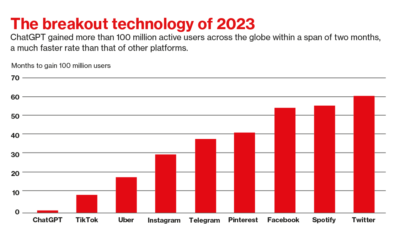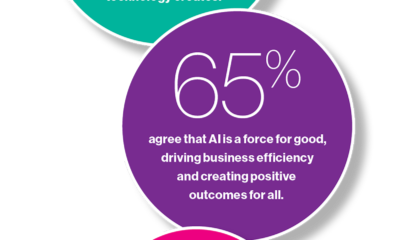Politics
AWS: Embracing the Power of Generative AI
Published
10 months agoon
By
Drew Simpson
Since its inception, artificial intelligence (AI) has been the subject of much discussion and conjecture, with some of the most prominent figures in the technology industry voicing concerns about the potential existential threat it poses. On the other hand, Matt Wood, who is the vice president of product at AWS, has a different point of view.
Wood, a well-known figure in the field of machine learning (ML), is of the opinion that artificial intelligence (AI) is not a danger but rather a potent instrument that has the potential to completely transform businesses. This article will discuss Amazon Web Services’ (AWS) journey with artificial intelligence (AI) and its embrace of generative AI, highlighting the transformative power that AI holds for businesses.
AWS has been at the forefront of artificial intelligence and machine learning developments for more than a decade. Over 100,000 of AWS’s customers have been given the ability to build, train, and deploy their very own machine learning models thanks to the Sagemaker product suite. The trust and confidence that businesses have in AWS’s capabilities is displayed by the adoption of ML services.
A new level of attention and excitement has been generated among AWS customers as a result of the introduction of Generative AI, which takes AI and ML to an entirely new level. As a result of the development of transformer models, it is now possible to map complex inputs in natural language to intricate outputs for a variety of tasks, including the generation of text, the summarization of information, and the creation of images. In his article, “The Potential for Generative AI to Revolutionize Industries,” Wood draws parallels between the early days of generative AI and the early days of cloud computing.
There are a variety of business applications for generative AI that go well beyond the generation of text and images. The numerical vector embeddings that are at the heart of large language models (LLMs) provide businesses with the ability to improve customer experiences by means of semantic scoring and ranking. LLMs provide a significant advantage in summarizing and personalizing content, whether the goal is to improve search engines or to make it more accessible to individual users.
Amazon Bedrock is a new service offered by AWS that aims to make the advantages of using multiple LLMs more accessible. This service gives users access to a variety of options from a number of different vendors, such as AI21, Anthropic, Stability AI, and the Amazon Titan models. AWS recognizes that there is not a single solution that is optimal for all users and aims to satisfy the various needs of its customers by providing a model selection option.
Langchain is a tool offered by Amazon Web Services (AWS) that works in conjunction with Amazon Bedrock and enables businesses to utilize multiple LLMs all at once. Users of Langchain have the ability to chain and sequence prompts across multiple models. This provides businesses with the flexibility to use models such as Titan, Anthropic, AI21, or even their very own custom models that are based on particular data. Users are granted the ability, as a result of this flexibility, to break down large tasks into a series of smaller ones, thereby producing more complex systems.
As more and more businesses adopt generative AI, there will inevitably be obstacles to surmount. Wood stresses how essential it is to approach the technology with an innovative mindset and a solid cultural basis. Even though there is a significant emphasis placed on the technical aspects, the shift in cultural values is just as important to propel invention through the use of technology.
Wood is of the opinion that artificial intelligence is nothing more than a “mathematical parlor trick,” in contrast to the widespread belief that AI poses an existential risk. He places a strong emphasis on the fact that the true power of AI lies in its capacity to present, generate, and synthesize information. This provides humans with the ability to make better decisions and function more effectively. The viewpoint that Wood presents is reflective of AWS’s dedication to maximizing the potential of AI for the advantage of businesses and society as a whole.
On July 11-12, 2019, top executives and industry leaders will convene in San Francisco for the Transform 2023 conference to delve deeper into the realm of artificial intelligence (AI). At this event, attendees will gain valuable insights into how businesses have integrated and optimized their investments in AI for success while avoiding common pitfalls. Do not pass up the chance to get ahead of the generative AI revolution by missing out on this opportunity.
AWS has solidified its position as a market leader in artificial intelligence (AI) and machine learning (ML), with a primary emphasis on generative AI. AWS gives businesses the tools they need to unleash the power of multiple LLMs and to drive innovation through the use of services such as Amazon Bedrock and Langchain, both of which are part of AWS’s product lineup. The viewpoint of Matt Wood, who views artificial intelligence as a mathematical parlor trick, sheds light on the enormous potential of generative AI to assist humans in making better decisions and functioning more effectively. AWS continues to be at the forefront of the AI revolution, enabling businesses to capitalize on the transformative potential of AI and maintaining its position at the forefront.
First reported on VentureBeat
Frequently Asked Questions
Q: What is Amazon Web Services (AWS)?
A: Amazon Web Services (AWS) is a subsidiary of Amazon that provides a comprehensive suite of cloud computing services to individuals, businesses, and organizations. It offers a wide range of tools and resources to enable businesses to build, deploy, and manage their applications and services in a flexible and scalable manner.
Q: What is generative AI?
A: Generative AI refers to the use of artificial intelligence techniques to generate new content, such as text, images, or other forms of data, that resembles or imitates human-created content. It utilizes advanced models, such as transformer models, to map complex inputs to intricate outputs and has the potential to revolutionize various industries.
Q: How has AWS embraced generative AI?
A: AWS has been at the forefront of artificial intelligence and machine learning developments for over a decade. With the introduction of generative AI, AWS has provided customers with the ability to leverage transformer models and generate text, summarize information, create images, and more. It has also launched services like Amazon Bedrock and Langchain to make multiple large language models (LLMs) accessible and allow businesses to chain and sequence prompts across various models.
Q: What are the business applications of generative AI?
A: Generative AI has numerous business applications beyond text and image generation. Large language models can improve customer experiences through semantic scoring and ranking, aiding content summarization and personalization. Amazon Bedrock, in conjunction with Langchain, offers businesses the flexibility to utilize multiple LLMs simultaneously, allowing them to break down large tasks into smaller ones and create more complex systems.
Q: How does AWS cater to the needs of its customers in generative AI?
A: AWS recognizes that different customers have varying requirements and preferences when it comes to generative AI. Amazon Bedrock provides access to multiple LLM options from different vendors, while Langchain enables users to chain and sequence prompts across models, including custom models. This selection and flexibility empower businesses to choose the models that best suit their needs and goals.
Q: What does Matt Wood’s viewpoint on AI signify?
A: Matt Wood, the vice president of product at AWS, holds the viewpoint that artificial intelligence is not a danger but a powerful tool that can transform businesses and enable better decision-making. He emphasizes that the true strength of AI lies in its ability to present, generate, and synthesize information, enhancing human capabilities rather than posing existential risks.
Brad Anderson
Editor In Chief at ReadWrite
Brad is the editor overseeing contributed content at ReadWrite.com. He previously worked as an editor at PayPal and Crunchbase. You can reach him at brad at readwrite.com.
You may like
-


Navigating a shifting customer-engagement landscape with generative AI
-


Making an image with generative AI uses as much energy as charging your phone
-


Finding value in generative AI for financial services
-


Four ways AI is making the power grid faster and more resilient
-


The Download: what is death, and jailbreaking generative AI
-


Humans at the heart of generative AI
Politics
Fintech Kennek raises $12.5M seed round to digitize lending
Published
7 months agoon
10/11/2023By
Drew Simpson
London-based fintech startup Kennek has raised $12.5 million in seed funding to expand its lending operating system.
According to an Oct. 10 tech.eu report, the round was led by HV Capital and included participation from Dutch Founders Fund, AlbionVC, FFVC, Plug & Play Ventures, and Syndicate One. Kennek offers software-as-a-service tools to help non-bank lenders streamline their operations using open banking, open finance, and payments.
The platform aims to automate time-consuming manual tasks and consolidate fragmented data to simplify lending. Xavier De Pauw, founder of Kennek said:
“Until kennek, lenders had to devote countless hours to menial operational tasks and deal with jumbled and hard-coded data – which makes every other part of lending a headache. As former lenders ourselves, we lived and breathed these frustrations, and built kennek to make them a thing of the past.”
The company said the latest funding round was oversubscribed and closed quickly despite the challenging fundraising environment. The new capital will be used to expand Kennek’s engineering team and strengthen its market position in the UK while exploring expansion into other European markets. Barbod Namini, Partner at lead investor HV Capital, commented on the investment:
“Kennek has developed an ambitious and genuinely unique proposition which we think can be the foundation of the entire alternative lending space. […] It is a complicated market and a solution that brings together all information and stakeholders onto a single platform is highly compelling for both lenders & the ecosystem as a whole.”
The fintech lending space has grown rapidly in recent years, but many lenders still rely on legacy systems and manual processes that limit efficiency and scalability. Kennek aims to leverage open banking and data integration to provide lenders with a more streamlined, automated lending experience.
The seed funding will allow the London-based startup to continue developing its platform and expanding its team to meet demand from non-bank lenders looking to digitize operations. Kennek’s focus on the UK and Europe also comes amid rising adoption of open banking and open finance in the regions.
Featured Image Credit: Photo from Kennek.io; Thank you!
Radek Zielinski
Radek Zielinski is an experienced technology and financial journalist with a passion for cybersecurity and futurology.
Politics
Fortune 500’s race for generative AI breakthroughs
Published
7 months agoon
10/11/2023By
Drew Simpson
As excitement around generative AI grows, Fortune 500 companies, including Goldman Sachs, are carefully examining the possible applications of this technology. A recent survey of U.S. executives indicated that 60% believe generative AI will substantially impact their businesses in the long term. However, they anticipate a one to two-year timeframe before implementing their initial solutions. This optimism stems from the potential of generative AI to revolutionize various aspects of businesses, from enhancing customer experiences to optimizing internal processes. In the short term, companies will likely focus on pilot projects and experimentation, gradually integrating generative AI into their operations as they witness its positive influence on efficiency and profitability.
Goldman Sachs’ Cautious Approach to Implementing Generative AI
In a recent interview, Goldman Sachs CIO Marco Argenti revealed that the firm has not yet implemented any generative AI use cases. Instead, the company focuses on experimentation and setting high standards before adopting the technology. Argenti recognized the desire for outcomes in areas like developer and operational efficiency but emphasized ensuring precision before putting experimental AI use cases into production.
According to Argenti, striking the right balance between driving innovation and maintaining accuracy is crucial for successfully integrating generative AI within the firm. Goldman Sachs intends to continue exploring this emerging technology’s potential benefits and applications while diligently assessing risks to ensure it meets the company’s stringent quality standards.
One possible application for Goldman Sachs is in software development, where the company has observed a 20-40% productivity increase during its trials. The goal is for 1,000 developers to utilize generative AI tools by year’s end. However, Argenti emphasized that a well-defined expectation of return on investment is necessary before fully integrating generative AI into production.
To achieve this, the company plans to implement a systematic and strategic approach to adopting generative AI, ensuring that it complements and enhances the skills of its developers. Additionally, Goldman Sachs intends to evaluate the long-term impact of generative AI on their software development processes and the overall quality of the applications being developed.
Goldman Sachs’ approach to AI implementation goes beyond merely executing models. The firm has created a platform encompassing technical, legal, and compliance assessments to filter out improper content and keep track of all interactions. This comprehensive system ensures seamless integration of artificial intelligence in operations while adhering to regulatory standards and maintaining client confidentiality. Moreover, the platform continuously improves and adapts its algorithms, allowing Goldman Sachs to stay at the forefront of technology and offer its clients the most efficient and secure services.
Featured Image Credit: Photo by Google DeepMind; Pexels; Thank you!
Deanna Ritchie
Managing Editor at ReadWrite
Deanna is the Managing Editor at ReadWrite. Previously she worked as the Editor in Chief for Startup Grind and has over 20+ years of experience in content management and content development.
Politics
UK seizes web3 opportunity simplifying crypto regulations
Published
7 months agoon
10/10/2023By
Drew Simpson
As Web3 companies increasingly consider leaving the United States due to regulatory ambiguity, the United Kingdom must simplify its cryptocurrency regulations to attract these businesses. The conservative think tank Policy Exchange recently released a report detailing ten suggestions for improving Web3 regulation in the country. Among the recommendations are reducing liability for token holders in decentralized autonomous organizations (DAOs) and encouraging the Financial Conduct Authority (FCA) to adopt alternative Know Your Customer (KYC) methodologies, such as digital identities and blockchain analytics tools. These suggestions aim to position the UK as a hub for Web3 innovation and attract blockchain-based businesses looking for a more conducive regulatory environment.
Streamlining Cryptocurrency Regulations for Innovation
To make it easier for emerging Web3 companies to navigate existing legal frameworks and contribute to the UK’s digital economy growth, the government must streamline cryptocurrency regulations and adopt forward-looking approaches. By making the regulatory landscape clear and straightforward, the UK can create an environment that fosters innovation, growth, and competitiveness in the global fintech industry.
The Policy Exchange report also recommends not weakening self-hosted wallets or treating proof-of-stake (PoS) services as financial services. This approach aims to protect the fundamental principles of decentralization and user autonomy while strongly emphasizing security and regulatory compliance. By doing so, the UK can nurture an environment that encourages innovation and the continued growth of blockchain technology.
Despite recent strict measures by UK authorities, such as His Majesty’s Treasury and the FCA, toward the digital assets sector, the proposed changes in the Policy Exchange report strive to make the UK a more attractive location for Web3 enterprises. By adopting these suggestions, the UK can demonstrate its commitment to fostering innovation in the rapidly evolving blockchain and cryptocurrency industries while ensuring a robust and transparent regulatory environment.
The ongoing uncertainty surrounding cryptocurrency regulations in various countries has prompted Web3 companies to explore alternative jurisdictions with more precise legal frameworks. As the United States grapples with regulatory ambiguity, the United Kingdom can position itself as a hub for Web3 innovation by simplifying and streamlining its cryptocurrency regulations.
Featured Image Credit: Photo by Jonathan Borba; Pexels; Thank you!
Deanna Ritchie
Managing Editor at ReadWrite
Deanna is the Managing Editor at ReadWrite. Previously she worked as the Editor in Chief for Startup Grind and has over 20+ years of experience in content management and content development.
